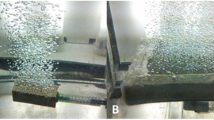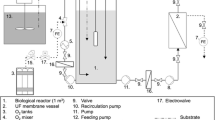Abstract
Optimal operation condition was investigated for immobilized rice callus culture using a turbine blade reactor (TBR2) with polyurethane foam supports. By using polyurethane foam block as immobilization support, the inhibition of cell growth at a high agitation speed was avoided because the hydrodynamic stress against immobilized cell was probably reduced. Experimental results in each operational condition were assessed by means of rice callus growth, immobilization ratio in TBR and those regeneration frequencies in regeneration culture using solid medium. Concerning with pore size of polyurethane foam and support size, three-millimeter cube support of polyurethane foam with an average pore size of 1.3 mm was the most suitable support. The maximum immobilization ratio was 50% under 5% support volume by volume of growth medium. For improving the immobilization ratio of rice callus in the TBR, the optimum TBR operation and modification were investigated further. By repeating a periodic operation 3 times (agitating at 300 rpm for 5 min and then 50 rpm for 2 min, and then 200 rpm of constant agitation speed during the remaining time), almost all supports could entrap rice callus and homogeneous immobilization was attained. The immobilization ratio was improved as compared with that using a constant operation at 200 rpm. Next, the TBR was modified by setting an air sparger inside the stainless mesh cylinder. In the modified TBR, the floating support by air bubbles was reduced, and the immobilization ratio increased further and reached 86.3% when we increased the support volume to 15% under periodic operation on a daily basis. The regeneration frequency of immobilized callus was also slightly increased by periodic operation and modification of the TBR.
Similar content being viewed by others
References
Ling, D. H., W. Y. Chen, and Z. R. Ma (1983) Somatic embryogenesis and plant regeneration in an interspecific hybrid ofOryza.Plant Cell Rep. 2: 161–171.
Abe, T., and Y. Futsuhara (1985) Efficient plant regeneration by somatic embryogenesis from root callus tissue of rice (Oryza sativa L.).J. Plant Physiol. 121: 111–118.
Chen, T. H., L. Lam, and S. C. Chen (1985) Somatic embryogenesis and plant regeneration from cultured young inflorescences ofOryza sativa L. (rice).Plant Cell Tiss. Org. Cult. 4: 51–54.
Mitsuoka, K., H. Honda, X. H. Xing, and H. Unno (1994) Effect of intracelluar 2,4-D concentration on plantlet regeneration of rice (Oryza sativa L.) callus.Appl. Microbiol. Biotechnol. 42: 364–366.
Tsukahara, M., T. Hirosawa, and S. Kishine (1996) Efficient plantlet regeneration from cell suspension cultures of rice (Oryza sativa L.).J. Plant Physiol. 149: 157–162.
Moon, K. H., H. Honda, and T. Kobayashi (1999) Development of a bioreactor suitable for embryogenic rice callus culture.J. Biosci. Bioeng. 87: 661–665.
Seki, M., C. Ohzora, M. Takeda, and S. Furusaki (1997) Taxol (paclitaxel) production using free and immobilized cells ofTaxus cuspidata.Biotechnol. Bioeng. 53: 214–219.
Hulst, A. C., M. M. T. Meyer, H. Breteler, and J. Tramper (1989) Effect of aggregate size in cell cultures ofTagetes patula on thiophene production and cell growth.Appl. Microbiol. Biotechnol. 30: 18–25.
Brodelius, P., B. Deus, K. Mosbach, and M. H. Zenk (1979) Immobilized plant cells for the production and transformation of natural products.FEBS Lett. 103: 93–97.
Lindsey, K., M. M. Yeoman, G. M. Black, and F. Mavituna (1983) A novel method for the immobilization and culture of plant cells.FEBS Lett. 155: 143–149.
Nakajima, H. K., H. Sonomoto, H. Morikawa, F. Sato, K. Ichimura, Y. Yamada, and A. Tanaka (1986) Entrapment ofLavandula vera cells with synthetic resin prepolymers and its application to pigment production.Appl. Microbiol. Biotechnol. 24: 266–270.
Liu, Y. C., M. Seki, H. Tanaka, and S. Furusaki (1998) Characteristic of Loofa (Luffa cyclindrica) sponge as a carrier for plant cell immobilization.J. Ferment. Bioeng. 85: 416–421.
Rhodes, M. J. C., J. I. Smith, and R. J. Robins (1987) Factors affecting the immobilization of plant cells on reticulated polyurethane foam particles.Appl. Microbiol. Biotechnol. 26: 28–35.
Furuya, T., Y. Orihara, K. Koge, and Y. Tsuda (1990) Long term culture and caffeine production of immobilized coffee (Coffea arabica L.) cells in polyurethane foam.Plant Cell Rep. 9: 125–128.
Denchey, P. D., A. I. Kuklin, and A. H. Scragg (1992) Somatic embryo production in bioreactors.J. Biotechnol. 26: 99–109.
Honda, H., T. Oda, T. Shiragami, and H. Unno (1992) Effect of medium flow on regeneration of rice callus.Biotechnol. Tech. 6: 469–472.
Author information
Authors and Affiliations
Corresponding author
Rights and permissions
About this article
Cite this article
Moon, K., Liu, C., Honda, H. et al. Operational optimization of a turbine blade reactor using macroporous support and its application to rice callus regeneration. Biotechnol. Bioprocess Eng. 4, 294–299 (1999). https://doi.org/10.1007/BF02933756
Issue Date:
DOI: https://doi.org/10.1007/BF02933756




